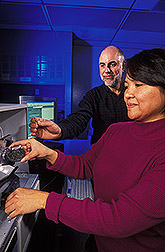This page has been archived and is being provided for reference purposes only. The page is no longer being updated, and therefore, links on the page may be invalid.
|
Agricultural Tool Recruited to Help Fight Malaria and Other Diseases
By Erin PeabodyMarch 3, 2005
It can be hard enough guessing a person's age, but can you imagine trying to tell an insect's? Engineers with the Agricultural Research Service (ARS), in a quest to quash grain-infesting bugs, have developed an instrument that can do just that.
And, unexpectedly, the technology is also proving useful in the battle to control disease-carrying insects, like mosquitoes and tsetse flies.
Developed by agricultural engineer Floyd Dowell and colleagues at the agency's Grain Marketing and Production Research Center (GMPRC) in Manhattan, Kan., the tool uses the invisible powers of near-infrared (NIR) light. All organisms, including insects, absorb NIR radiation differently, so the energy that's reflected back from any one of them will have its own unique signature.
GMPRC researchers originally built the instrument to assess grain kernels' protein content. But ARS entomologist James Baker thought that if the tool could effectively analyze grain composition, it should also be able to detect a live, growing insect hidden inside a kernel.
And that's not all. Entomologists with the Centers for Disease Control and Prevention in Atlanta, Ga., heard about GMPRC's tool and wondered if it could help identify mosquito species that carry malaria. CDC researchers would welcome a more streamlined sorting method, since it's difficult to distinguish between species that carry malaria and those that do not.
With Dowell's help, CDC entomologists are also using the ARS-developed technology to rapidly separate male and female tsetse flies. These tiny, biting insects carry the parasite that causes sleeping sickness, a disease ravaging several countries in Africa.
Using the instrument, Dowell has helped the researchers successfully sex and separate male and female tsetse flies while they are still pupae.
Being able to tell the sexes apart early in development allows researchers more time to sterilize male tsetse flies and transport them to strategic release sites in Africa. Releasing large numbers of sterile males, over time, should cause tsetse fly populations to ultimately crash.
Read more about the research in the March issue of Agricultural Research magazine:
ARS is the U.S. Department of Agriculture's chief scientific research agency.

